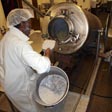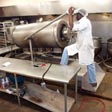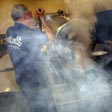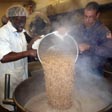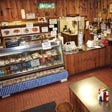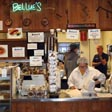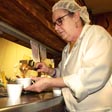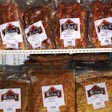A Master's Touch: Wirt Bellue's Inventions and Reinventions in the Workplace
By Douglas Manger
In occupational folklore, personal expression plays out in many ways. Storytelling—the spinning of a yarn or tale—has been one of the most popular modes of personal expression since time immortal. What better way to convey knowledge to your fellow workers than stories laced with humor and drama.
When Wirt Bellue spins a tale for a listener it's a hold-on-tight breathless stream of consciousness experience. His aren't tall tales, though they could be given their 'most folks wouldn't make that kind of effort' quality. No, Bellue's stories, or more aptly, personal experience narratives, are all about the challenges he has taken on both for business and pleasure.
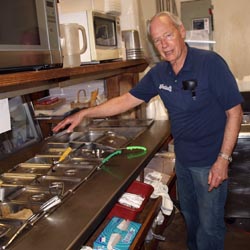
While his stories are compelling enough, the question lingers are their underlying meanings at play? Bellue speaks in a soft Louisiana accent that rests easy on the ears. A tap on the shoulder from time to time helps make the point. With careful listening one senses Bellue's comments are as much about what we can accomplish if we apply ourselves as they are about his successes in designing more efficient units for his facility. But there is more. The benefits gained in caring for others is also a message that comes out.
First Came Welding
Bellue's Fine Cajun Cuisine located on Scenic Highway just north of the city center, has been a landmark location in Baton Rouge for almost 50 years. Once a busy north/south artery much of the traffic that once traveled up and down Scenic Highway can now be heard rushing by on the I-110 Interstate that looms overhead just east of Bellue's.
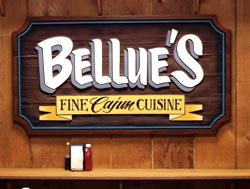
"Most everybody has left this area here. . . . It was a lot of the old, you know, Baton Rouge people were here. . . . I'm one of the few old original residents," Bellue commented. Once a racially diverse, modest, yet stable neighborhood, many of the long-standing residents of the area were employed at the Exxon refinery strung along the west side of Scenic Highway. Today the neighborhood is majority African American. With declining property values and the highest crime rate in the city, the area struggles to hold its own.
For the first-time visitor it may appear that time has passed this section of Baton Rouge by. A closer look at Bellue's private enterprise zone on the corner of Scenic Highway and Erie Street, however, reveals a far different picture. No, time hasn't passed Bellue by. Instead, in creative frenzy, he has for long periods held time at bay to allow himself the creative space necessary to engineer yet another novel labor-saving device for his restaurant [or as he called it, his] facility.
Wirt Bellue is an entrepreneur's entrepreneur. The commonsensical occupational folk acumen at play in his work life today was instilled in him by family from early childhood on. While Bellue's passion for foodways remains at the core, specific, non-negotiable, overarching value sets drive his work. A striving for perfection along with a desire to serve and please others, are mainstays. "If I engage into anything," Bellue offered, "it's got to be right or I'm not going to fool with it."
Curiously Bellue's interest early on was more in the line of welding and fabrication, than foodways, sparked by an opportunity that came his way in high school. A small oil company in the area hired "a bunch of us local school boys," he explained. Bellue found himself assigned as a welder's helper. "I guess that's what kind a what got me generated in the welding. . . . I really idolized him. He could weld and do all of these things, and I never been around anything like that," Bellue recounted. Despite a working relationship that would continue for a number of years the master welder remained highly protective of his work. Not once did he allow Bellue to even as much strike an arc. "Let me tell you one thing," the welder declared when Bellue asked him one too many times if he could try his hand, "I don't teach no s.o.b. my trade. You might be the [one] that takes my job." Apart from welding pipe for the oil company, the work also entailed building trailers, a precursor to what lay a few years ahead for Bellue. Already his agile mind was gearing up for what was to be.
With high school behind him Bellue joined the Baton Rouge Police Force. After his initial training he quickly found himself on the beat directly in harm's way at a time of mounting racial tensions. As time progressed, with a wife and children at home, Bellue became increasingly insecure about his line of work. As a release he finally convinced himself to invest $125 in a welding machine. Fortunately family members were close at hand to give him tips on welding. Before long Bellue was at "play" night after night in the shed behind his house welding up pieces of metal. "Man, I've never been so happy in all my life. I couldn't wait to get home and piddle and play," he shared. Bellue's new-found bliss was quickly dampened, however, when his neighbors circulated a petition claiming he was operating a commercial business in a residential neighborhood. "When bad things like this happen sometimes it opens other doors for you," Bellue commented. "I'd probably never wound up in business." The ruckus caused by the neighborhood petition led him on a hunt for a commercial workspace. With the help of his contacts Bellue soon located one. For $37.50 a month rent he was set to launch his part-time welding repair business. The location at the crossroads of Scenic Highway and Erie Street is where he remains to this day.
With a new sign out front, customers in need of small repairs soon began to trickle in. He started small, with a broken wheel bracket on a lawnmower, for example. As his confidence grew Bellue took on more ambitious projects. His first large-scale project was smokers requested by a few of his Black customers, hardcore garfish, and game meat eaters. To fabricate a smoker Bellue cut the bottom out of an old oil barrel, and the top out of another, then welded the two together. "I think that kind of helped generate my interest in smoking," he explained, "because I built myself one like they were telling, and I started smoking different pork loins and all this stuff. Some of the best meat I'd ever eaten like that, you know." With access to recycled oil drums free and clear, Bellue began building BBQ pits on a regular basis.
With his experience gained fabricating the BBQ pits, Bellue began to envision other types of cookers, but smaller in scale for everyday use. After much thought, he finally arrived at his "old wheel cooker thing." Not only was the design totally original, it was somewhat environmentally friendly, as well, with the units made-up partially from recy-cled automobile tire rims.
The fabrication process was straightforward enough. A 14 or 15 inch auto tire rim "that they were throwing away" was fitted with four legs to elevate it to roughly knee high. A built-in butane blower burner was then installed in the center hole of the wheel where the hub came through. To finish out, small steel rods were welded in place on top of the burner to create a grill where the cooking pot could sit. The tire rim, which also functioned as a wind guard, made for a remarkably durable burner. Bellue's cooker came complete with an accessory burner, gas cylinder, and hose attachment. "Of course, thing is," Bellue added, "those things that we built 40 years ago, most of them are still around. You know, they are well built. Made a really fine little cooker."
At a time when butane cookers were simply not available, Bellue's novel creation was a grand success. So much so that Bellue had to scramble for help. When help arrived on the scene, his best new hire could soon weld up to 70 units a day. The success of Bellue's "old wheel cooker thing" led to spin-offs designs including one unit that you could push about. "We probably pioneered the actual outdoor cooker business," Bellue observed. "And man, we sold thousands of them. . . . Of course, being a perfectionist—I'm a damned perfectionist—if I engage into anything, you know, it's got to be right or I'm not going to fool with it." With that, Bellue laughed, "My sister says that's a curse. She's the same way and my brother's the same way."
Over time Bellue's product line expanded yet again moving beyond the BBQ pits and butane cookers. Harkening back to his experience as a welder's helper, Bellue set his sights next on building custom trailers. As was his practice from the very beginning, in lieu of sketching out each piece, Bellue visualized in his mind how best to design the project, and then moved directly into production. "When I get into something like this I go days just, you know, my mind. . . . I never could do anything like that as far as drawing blueprints or reading blueprints, but if I ever get on a project like this in my mind, I'll formulate exactly. I see it clearly in my mind and then I go put it together." First in production were small-scale luggage and dog trailers. To ensure all the trailers were dimensioned precisely the same from one unit to the next, Bellue came up with an ingenious system of adjustable jigs. "But to sit there and think about doing something like this and building it, every burner, and every BBQ pit, and every trailer is [he trails off]. Of course you've eliminated all your guess work. Anybody could build it now and they all the same." Bellue was quick to point out—if the same jigs were used today—when the new trailer was finished it would be an exact duplicate of the original, built some 40 years ago, with the same perfectly squared corners. "In building the jigs," he continued, "everything was meticulously set to where it was perfectly square. Not square, I mean perfect. So that every trailer that I built from thereafter was perfectly square." By using the adjustable jigs Bellue also managed to reduce his labor costs substantially. Saturday mornings before noon "it wasn't anything for us to weld up 10 trailer frames," he commented.
Other projects would follow to include a custom-designed rotisserie mounted on a trailer. "I take two wild hogs and put in there. I got them on a rotisserie. Oh, man, some of the best eating you've ever . . . ." Of course, Bellue designed the units with his own twist. Running counter to convention, instead of minimizing the effect of the heat source by positioning it at one end of the BBQ pit laid out on the horizontal, Bellue's cookers were laid out vertically to optimize the heat source. "Heat don't run sideways," he exhorted. "Do you understand? Heat rises. That's the first thing they going to tell you in the first science class you ever go in." Accordingly, with Bellue's design, when a small fire is lit at the base of the BBQ pit, as the heat works its way up to the top it radiates out. [It's] a simple formula.
Despite his early successes in the welding trade Bellue kept on with the Baton Rouge Police Force. But life would change when an on-the-job accident placed him on Work-men's Compensation for a time. "I gotten my back busted up. I got an old shoulder tore off with some guys that, you know, was fighting some guys." During his recuperation time Bellue began to cook more "boudin and some of the old things I had been doing all the years." Restricted from working in his welding shop a few steps from his house, "I had to have something to do," he explained. With the aromas from his kitchen wafting in the air it didn't take long for his shop employees to begin sending customers back to Bellue's house to sample his hog head cheese, sausage, Cajun boudin, or whatever else was in the pot. "Next thing, you know, the word got out and people started coming to my door," Bellue recalled. "'Say man, we heard about this boudin', or, 'We heard about this hot tamale,' [or,] 'You make sausage and stuff?'" Before he knew it "there was a beaten path to the door to the little house back here."
It was "a love and a knack for fooling with it" that kept Bellue's passion for cooking on track. About this time a friend who ran a grocery store asked Bellue "to make some stuff for him." When he did, the response was overwhelmingly positive. The grocer's customers seemed to love Bellue's cooking. Inspired by the reaction he began to develop his own line of hot tamales. When finally they passed muster on his strict taste test, "customers went crazy over them." Bellue was more than pleased. Formulating the Cajun hot tamale recipe had been one of his biggest challenges to date. "[I] must have thrown 1000's of pounds of meat and meal away trying to perfect that."
Yet despite the positive response, in an uncharacteristic move, Bellue decided to try to cut corners by adding more low-cost corn meal to his tamale recipe. His cost-cutting move proved disastrous. Customers soon began returning product complaining to the grocer that the tamales didn't taste the same. With a pained expression, Bellue recalled, "So it really taught me a good lesson early on. The hell with it. Make the very best product you can make and if you have to adjust the price a little bit, adjust the price." Today he regards the sheer folly of continuing on when you know at heart the food is not up to standard, and in the end, it must be thrown out. "That's the greatest thing anybody taught me."
With his grocery accounts firmly established, Bellue, now a Captain on the Baton Rouge Police Force, made the decision to build a proper facility to prepare the food for the grocery stores he was now serving. This facility is present-day Bellue's Fine Cajun Cuisine, now closing in on 50 years of operation. Bellue's approach with his new food enterprise mirrored his approach to his welding business. Every process in the new facility was examined to see how it could be made more efficient. Exacting quality controls, Bellue realized, would bring the consistency he was seeking. Bellue remarked:
You want to have quality control. Most of the food products that we do are 1000 pound batches. And, of course, we're kind of like Exxon across the street. . . . Once we figure out what works, we [are] able to go back and recreate. So we [are] basically not cooking food so much as we're processing. We process just like Exxon would process a batch of crude oil . . . and, for instance, when we do one real popular side dish here, we do 800 pounds of white beans in this pot.
The pot referred to above is "Bellue's Pressurized Rotary Cooker (BPRC)," designed for cooking up to one-thousand pound batches of food. Looking every bit like a small mis-sile, the patented cooker—masterfully designed by Bellue—is cylindrical in shape with a 3 inch thick jacket. The unit measures 6 feet in length, 24 inches in diameter. With a gleam in his eye Bellue shouted out over the roar of the industrial fans, "It is one heck of a cooking machine." Interchangeable heads provide for many uses: pressure cooker, wet or dry mixer, browner, vacuum tumbler. Even the 3 inch diameter heat jacket serves multiple purposes. Flooded with cold water it acts as a chiller stopping the cooking process. When used as a pressure cooker the cylinder rotates inside the heat jacket. Accommodating 1000 pound bags of assorted products is not an issue. Burners capable of generating 800,000 BTU's are positioned underneath the BPRC. When used as a dry mixer to work in seasonings, and to break up the protein, the unit is capable of mixing/tumbling 500 to 700 hundred pounds of meat at one time. The BPRC can also be fitted with an injector, a device capable of injecting turkeys with seasonings in 4 seconds flat before they are cooked.
Bellue is now in the process of designing a mechanism that will actually rock the BPRC while it is in use, a task currently done manually. The BPRC comes equipped with many different heads, not only to build pressure, but to "pull vacuum" in the tumbler. When pulling vacuum, seasonings are literally sucked into the meat.
Once we figure out what works," Bellue explained, "we're able to go back and recreate precisely, exactly that same cooking environment." Strict quality controls ensure that the white beans of today will taste "precisely, exactly" the same a year from now. "I have totally addressed every avenue, every crack and crevice in this operation," Bellue ex-plained," and, of course, to get where I am today—I'm 70 years old—it's been a long time coming. . . . Anything that we do here, we don't cut any corners."
Over time Bellue has devised precise formulations for each menu item. His cookbook, basically a catalogue of recipes, lists the steps for preparing each menu item. All proportions are listed in grams. Bellue remains ever thankful to a good friend for transfer-ring his recipes—at one time written on scraps of paper stored at random in a cardboard box—to a master reference cookbook with all of his "formulations" clearly laid out on each page for the next owner of the business. "I mean it's pretty simple. You know I think anybody could formulate this thing up and carry on."
All food items at Bellue's are freeze-dried after cooking. [Bellue explains the process]:
We make big batches of food. We immediately seal it into a vacuum bag to remove all the oxygen which, in-turn, eliminates the possibility of bacteria and spoilage. And it immediately goes to the freezer. So never have to worry about anybody getting sick. Never have to worry, you know, the rotation of the food. It matters not who is serving. The process throughout from cooking to vacuum packing to serving out front is always the same. That gives us good quality control across the counter. Everything we pass across the counter is always the same.
Innovation for Food Preparation
A symbiotic relationship exists between Bellue's food preparation facility and his welding shop next door. "It's been a real asset to have a big welding business next door and you go over and you make all of these things," he stated. "I've designed and built so many different things that's made this operation just, I mean, almost trouble free." If a particular kitchen ladle is needed to stir a roux, in no time Bellue can turn one out in the shop next door.
A Bellue (re)innovaton is evident at every turn in his facility. The serving table in the front kitchen area, for example, was custom-designed to keep 200 gallons of hot water at a constant 187 degree temperature, 24 hours a day. Once frozen food items are thawed in the hot water they're ready to be served. At that point "everything that we pass across the counter is always the same," Bellue reiterated.
In the back kitchen area Bellue created a more efficient burner to heat large cooking pots. By replacing the smaller rods on the heating element with heavier, solid, 1 inch bar stock, Bellue eliminated the problem of the smaller rods bending when heated. In addition with the thicker bar stock the heat radiates out far better than with the smaller rods.
Another (re)innovation is a rotating grill that is used to toast large numbers of poboy buns. "This is how my mind works. I'm trying to get something that I can do massive volumes of bread, you know, and get them all the same," Bellue recounted. The rotating grill he designed, ¾ inch thick, can accommodate 40 poboy buns at a time. A heavy-duty lid drops down to keep the buns in place. Unlike a conventional grill there are no hot and cold spots on Bellue's grill. With its novel design the temperature remains constant on the grill surface regardless of where the buns are placed. "There again, there's something here when I do it," Bellue laughed, "I get a kick out of how well this thing works every time."
The smokehouse behind Bellue's Fine Cajun Cuisine, 16 feet in height, is yet another example of home-grown Bellue ingenuity. Meats prepared in the smokehouse are raised or lowered in the chamber with the aid of a pulley system. Bellue's approach when smoking his meats is to first build a pecan wood fire. At times he mixes oak with the pecan. "This is the old, old-fashioned way that they did it. You slow, slow fire, you know, 90 degrees, 100 degrees, somewhere in there. And that heat just goes around. You come back here the next morning and that's the prettiest damn thing you ever seen in your life."
Bellue's personal field research led him to model his approach after old time meat smoking techniques used in Germany. The key, as he explained, is to first build a small fire. The low heat factor then works to slowly remove the water from the meat. Using this approach, the flavor of the meat is retained. And with the absence of water, where bacteria can grow, the meat will last. "We probably remove at least 15 to 20% of the water on most all of our [meat] products," Bellue pointed out.
To educate himself on traditional smoking techniques, Bellue personally sought out old time masters of the smokehouse. On one occasion he came across an old-timer whose approach to smoking meats differed radically from traditional folk cookery practices. Contrary to the ordinary, this unnamed original thinker was accustomed to smoking his meats in the middle of the summer, as well. [He revealed] his secret: "Son, if you use fresh meat, you'll never have a problem." To be certain, the meat he smoked was always butchered the day prior.
Bellue's appetite for invention goes beyond his work place. For starters he invites visitors to step outside his facility and look up. If their timing is right, a string of colossal wind chimes will be swaying in the breeze forty seven feet in the air suspended from his commercial sign overlooking the freeway. The wind chimes can be raised on a whim, especially when the grandchildren are visiting. Measuring 16 feet in length, each chime is fashioned from a recycled oxygen cylinder bottle. "It's very, very fine steel and it [the chime] has a good ring to it . . . just like a regular wind chime, but much, much heavier scale," Bellue commented. On top of the sign itself Bellue has mounted a series of bells to compliment the three vintage steam whistles. One of the steam whistles, upwards of 100 year old, at one time was in use at the local Delta Tank Manufacturing Company. One hundred forty pounds of air pressure drives the steam whistles.
Then, of course, there is Bellue's custom-made porch swing glider made from 1/8 inch steel plate. At his Mississippi weekend home, Bellue designed a similar model then de-cided to mount it on a 60 foot monorail with an electric motor. "I ride off of the porch and look at the sky," he laughed, "and go back and forth. I get people [who] come to my house. 'Mr. Bellue, we heard about this swing. Do you mind if we come?'"
Today Bellue's gravel separator, an oversize sifter mounted on wheels, remains his most challenging work-in-progress. "When I do something I really go to the extremes. . . . Right from the get go, I don't give up. I've been working on this thing for five or six years." Bellue remarked. "But this is quite an invention. . . . I can go down and make a few passes in the creek there and get three or four yards of gravel, you know, and head on and make my little road."
Bellue's Fine Cajun Cuisine
The steady stream of customers at Bellue's Fine Cajun Cuisine is sure-fire testament to the quality of food served five days a week. Determined not to disappoint, Wirt Bellue's formulations reflect his years of tweaking and working "trying to get all this stuff perfected." The results over time have been impressive. Consider Bellou's special holiday orders alone over the years—from the Pecan Smoked Turkey to the Pork Chops Stuffed with Seafood Dressing—"hundreds of thousands of pounds of food" have been processed through the operation with not one complaint from customers. "To me, if you just go ahead and make the best damn product you can possibly make, . . . people are going to come for it." Bellue continued. "I just have to do it right. I know when we were kids, . . . we'd go to my grandmother's house, my mom would always make us . . . trim all of the little yard parts. Do it right. . . . That's the way we were raised." With a wave of his hand, Bellue concluded, "My mind never quits. I never try to quit making something the best that it can be."
To the casual observer it may be hard to fathom just now much time and effort has gone into each of Bellue's visionary projects over the past 47 years. "I'd work and I'd see the sun coming up over here, . . . It's a lot of hard work and sometimes you felt like that you wasn't going to make it, and you really get kind of down about it, but you just had to keep [on]. . . . Lot of times you get up and start the day—the next day, you know—and it'd look a little different to you. But I'd work sometimes two or three days without ever even hardly taking a nap. . . . Just push myself. . . . But it's been a lot, a lot, a lot of hard work, but it's fun now." Bellue continued, "Everything else I've been pretty much self-taught. Not that I can't be taught something. But all this stuff is my original."
On a practical level, the net effect of Bellue's labor saving apparatus has been profound. Considering the volume of food processed at his facility, most operations as Bellue aptly pointed out, would maintain a staff of 20 people. By carefully scaling his business out, while developing strict protocols for food preparation, Bellue's system design improvements over time have resulted in an "almost labor free" work flow. Currently his food prep crew numbers three people, counting Bellue himself. In direct contrast, one of his friends in the business maintains a staff of from 15 to 20 people at his downtown restaurant.
Viewed through the lens of occupational folklore, Wirt Bellue's personal expression in the work place is realized in the creation of hardware that will improve and sustain the quality of his products. The level of satisfaction gained from successfully problem-solving his myriad projects, often years in the making, is difficult for Bellue to put into words. "And listen," he added, "it doesn't make any difference what that thing does in-side here to me by me thinking all these years about it and see it work. Money can't buy that, you know."
Bellue's altruistic approach in his work/life endeavors shines as a beacon of hope on a corner lot in a troubled neighborhood. His mind is always at work envisioning new ways to better his operations. These challenges have kept Bellue's creative juices flowing for all these decades. The ripple effect of his efforts is apparent both near and far. Witness the hungry refinery workers in the serving line anxious to dig into the daily special. Or consider the pipeline operator in the Dakota's 1500 miles distance eagerly awaiting those special touch-of-home frozen "Crawfish Etouffe" food packets direct from Bellue's.
Conclusion
As a young boy Bellue bellied up to the stove to try his hand at his very first batch of fudge. His success soon set everybody to bragging on him. These days, Bellue admits, he's still out to earn those same "attaboys" he got from family members way back then. In truth, with a five-star rating, those attaboys at Bellue's Fine Cajun Cuisine just keep on coming. "When you come to me and you want me to provide a service or a product for you, I mean, it's not about the money as much as it is seeing you satisfied and giving you what you paying for. I want your money, but I want you to be [happy]. . . . Mainly, it'd just break my heart for you to leave here and know that you talking bad about [me]; that you felt like I got over on you."
Leave it to the occupational folk mores instilled in Bellue by his parents: an exacting approach, the perfectionism. Yes, were it not for these tendencies that drive Bellue the corner of Scenic Highway and Erie Street would likely be no more than a collection of vacant buildings baking in the hot sun.
Sources
Bellue, Wirt. 2015. Interview by author. February 2.



